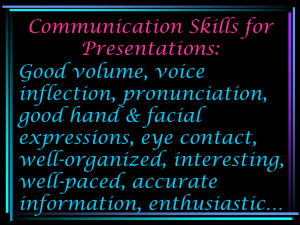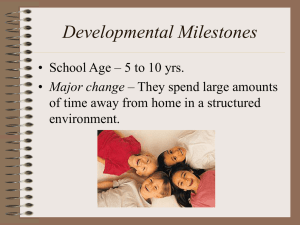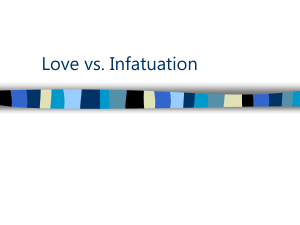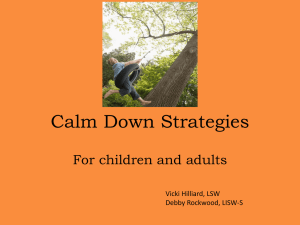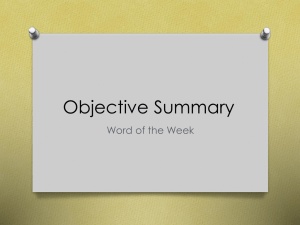Play Therapy in Schools_Directive_Techniques_ACSSW2014
advertisement
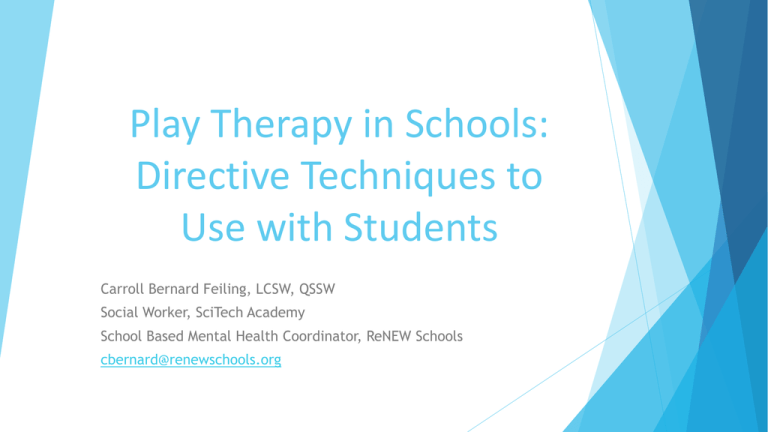
Play Therapy in Schools: Directive Techniques to Use with Students Carroll Bernard Feiling, LCSW, QSSW Social Worker, SciTech Academy School Based Mental Health Coordinator, ReNEW Schools cbernard@renewschools.org Objectives: The participant will be able to describe the important components of play therapy. The participant will be able to state examples of evidence-based practices using play therapy. The participant will learn at least 5 directive play therapy techniques to use immediately in the school setting. Why Play? Play is universal Play is the way children learn Play is essential to healthy development Children communicate through play Play is the concrete expression of the child and is the child’s way of coping with his or her world (Landreth, 2002.) What is Play Therapy? An approach to counseling young children in which the counselor uses toys,, art supplies, games, and other play media to communicate with clients using the “language” of child – the “language of play.” (Landreth) The systemic use of theoretical model to establish an interpersonal process wherein trained play therapists use the therapeutic powers of play to help clients prevent or resolve psychosocial difficulties and achieve optimal growth and development, (Association for Play Therapy http://www.a4pt.org/ ) Therapeutic Powers of Play Self expression Fantasy Compensation Direct and Indirect Teaching Reality Testing Abreaction Behavioral Rehearsal Stress Inoculation Rapport Building Catharsis Positive Emotion Attachment and Relationship Enhancement Empathy Power/Control Competence and Self Control Sense of Self Creative Problem Solving Schaefer (1999.) 7 Essentials in Play Therapy Establishment of a positive relationship with the child Expression of a wide range of feelings Exploration of real-life choices Reality of testing limits Development of positive self-image Development of self-understanding Opportunity to develop self-control www.a4pt.org History & Theories of Play Therapy Psychoanalytic Play Therapy – Freud 1900s Release Play Therapy – Levy 1930s Child Centered Play Therapy - Axline 1950s; Landreth Filial – Guerney 1960s; Landreth Eclectic / Prescriptive – Schaefer, Gil 1970s This approach tailors interventions to best match the needs and situation of the child client; the more remedies you have to offer the more effective you will be with a child client’s diverse set of problems 9Schaefer, 2003) Adlerian Play Therapy Jungian Play Therapy (including Sandtray) Cognitive Behavioral Play Therapy (including Bibliotherapy) Child Centered & Directive Competency in Child centered Play Therapy is a must for application of techniques Axline’s 8 Principles of Child Centered Play Therapy Must develop a warm and friendly relationship with the child. Accepts the child as he or she is. Establishes a feeling of permission in the relationship so that the child feels free to express his or her feelings. Is alert to recognize the feelings the child is expressing and reflects these feelings back in such a manner that the child gains insight into his/her behavior. Maintains a deep respect for the child’s ability to solve his/her own problems and gives the child the opportunity to do so. The child is responsible for his/her own choices and personal change. Does not attempt to direct the child’s actions or conversations in any manner. The child leads the way, the therapist follows. Does not hurry the therapy along. It is a gradual process and must be recognized as such by the therapist. Only establishes those limitations necessary to anchor the therapy to the world of reality and to make the child aware of his/her responsibility in the relationship Child Centered & Directive Rapport is essential prior to using techniques in play therapy treatment Directive Approach – technique application is not random, its curative and used to service needs of child and based on the identified treatment goals Why Directive Techniques? Time limits Behavior modification Play Therapy Results – Evidenced Based Ray, Bratton, Rhine, and Jones (2001) metaanalysis of 94 research studies focusing on the efficacy of play therapy as a viable intervention and found a large positive effect of play therapy on treatment outcomes with children. It has been demonstrated as an effective approach for a variety of presenting problems and diagnoses. (Landreth, 2002.) Decreased maladaptive school behaviors (Constantino, Malagady, & Roger 1986; Gaulden, 1975; Hannah, 1986; Leland, Ealker and Taboada, 1959) Play Therapy in Schools Play Therapy is encouraged to be used in the school setting to meet a broad range of he developmental needs of all children. Landreth (2002.) citing Alexander (1964); Muro (1968); Myrick and Holdin (1971); Nelson (1966); Waterland (1970) “The main question is not whether the elementary school counselor, school psychologist, or social worker, should use play therapy, but rather how play therapy should be used in elementary schools. Landreth (2002.) Outcome Research Studies to Support Play Therapies in Schools 1990 to Present Bratton (2010) in School Based Play Therapy… Summary of 51 studies of school-based play therapy research since 1990 Packman, J., & Bratton, S. (2003) A school-based group play/activity therapy intervention with learning disabled preadolescents exhibiting behavior problems Reams, R., & Fridrach, W. (1994). The efficacy of time-limited play therapy with maltreated preschoolers. Watson, D. (2007). An early intervention approach for students displaying negative externalizing behaviors associated with childhood depression: Efficacy of play therapy in the school. Directive Play Therapy Techniques Engagement/Rapport Identifying Ms. Building/Ice Breakers & Expressing Feelings B’s Favorites Bibliotherapy! Engagement/Rapport Building/Ice Breakers Stand Up If… Age: PK and up Modality: Group Materials: Pre-planned statements “Stand up if you have a pet” “Stand up if your parents are divorced” Variation – Cross to the Other Side If… Engagement/Rapport Building/Ice Breakers Jenga Age: 8 and up Modality: Individual, Group Materials: Jenga Pre-write Party questions on pieces Jenga Variation – Problem-Solution Jenga, Feelings Jenga Engagement/Rapport Building/Ice Breakers Don’t Spill the Beans! (Dr. Erin Dugan, Ph.D., LPC-S, RPT-S “Directive Techniques in Play Therapy”) Age: 6 and up Modality: Individual, Group Materials: Don’t Spill the Beans ® Different levels of questions Engagement/Rapport Building/Ice Breakers Thumb Ball Age: 6 and up Modality: Individual, Group Materials: Thumball™ product or Soccer Ball Write questions or statements on ball Variation – Feelings, Problem-Solution (many more!) Engagement/Rapport Building/Ice Breakers Candy Colors Age: PK and up Modality: Individual, Group Materials: M&Ms, Skittles, Jolly Ranchers Pre-determined categories or questions for each color Variation – Feelings, Anger (many more!) Anger Red - Something that makes me angry (trigger) Orange - One way my body lets me know I’m angry Feelings Red – enraged Orange - frustrated Yellow - confident Green – worried/anxious Purple – embarrassed Yellow - When I’m angry at home I…to calm down Green - When I’m angry at school I…to calm down Purple - Something I have done to make another person angry “Staying Out of the Mess” Red - What is mess? Orange - Give an example of how someone has been messy Yellow - Why are people messy? Green - Give an example of how you have been messy Purple - How do you stay out of the mess? Engagement/Rapport Building/Ice Breakers About Me Puzzle (Lowenstein, Liana. More Creative Interventions For Troubled Children and Youth.) Age: 7 and up Modality: Individual, Group Materials: About Me Puzzle, card board or construction paper, scissors, glue, magazine picture, envelope, tape Pre glue puzzle on one side and picture on the other Cut puzzle out and put in envelope Variation – blank jigsaw puzzles Identifying & Expressing Feelings Feeling Cards Age: PK and up Modality: Individual, Group Materials: Feeling Cards Pre-made with words and/or faces Variations Pull a card and everyone shares… a time they felt that way/made others feel that way/where they feel in their body Act it out an have others guess Taboo style Heads up style Others? Identifying & Expressing Feelings Feelings Bingo (http://peoniesandpoppyseeds.com/2013/05/freeprintable-bingo-game-about-feelings/) Age: PK and Up Modality: Individual, Group Materials: Laminated Bingo cards/caller cards, space markers (beads, beads, chips) Variations – show card, say feeling word, describe feeling, act out Identifying & Expressing Feelings Feelings Go Fish (Lowenstein, Liana. More Creative Interventions For Troubled Children and Youth.) Age: 6 and Up Modality: Individual, Group Materials: deck of cards, Go Fish Sheet (or faces w/ numbers), small treats Glue squares/faces on each corresponding card Variations – pairs or 4 of a kind; describe a time they have felt ___, act out, describe a time they made someone else feel ____, show their _____ face Identifying & Expressing Feelings Feelings Tic Tac Toe (Lowenstein, Liana. Creative Interventions For Troubled Children and Youth.) Age: 7 and Up Modality: Individual, Group Materials: Tic Tac Toe sheet, scorecard, 2 kinds of markers/pebbles/candy Laminate Tic Tac Toe sheet Variations – show the 3 feelings, tell about a time they made someone else feel them, a person who makes them feel the 3 feelings Identifying & Expressing Feelings Feelings Pick Up Sticks Age: 6 and up Modality: Individual, Group Materials: Pick Up Sticks Assign a feeling to each color Assign a task to each “round” per color Variations – Problem-Solution, Coping Skills Identifying & Expressing Feelings Feelings Matching Age: 6 and up Modality: Individual, Group Materials: Matching Game or double feeling cards Identifying & Expressing Feelings Candy Land Feelings (Lowenstein, Liana. Creative Interventions For Troubled Children and Youth.) Age: PK and up Modality: Individual, Group Materials: Candy Land ®, individually wrapped candy Individual pieces or group pieces Pre-arrange cards Assign feelings to colors Assign picture cards Identifying & Expressing Feelings Dart Gun Feelings Age: 8 and up Modality: Individual, Group Materials: Nerf Dart Gun, Feelings Poster Variations – post it notes (pin the tail on the donkey style); throw balls Identifying & Expressing Feelings Basketball(Lowenstein, Liana. Creative Interventions For Troubled Children and Youth.) Age: 7 and up Modality: Individual, Group Materials: hoop & ball; trash can and crumpled up paper Happy face cards Sad face cards Variations – spit balls Identifying & Expressing Feelings Guess Which Cup (Lowenstein, Liana. Creative Interventions For Troubled Children and Youth.) Age: 6 and up Modality: Individual Materials: 5 cups, 5 slips of paper, bingo chips Feelings related question on 4 slips of paper Three Extra Chips on 1 slip of paper Tailor it to age/treatment Variations – Anger, Problem-Solution, Coping Skills Younger Children: Show with your face and body what you look like when you feel angry. What makes you feel sad? What makes you feel happy? How would you feel if someone said something mean to you? Who do you talk to when you feel sad? Older Children What was the happiest day of your life? Name 3 things that make you feel mad When was the last time you cried? What happened that made you feel upset? What advice would you give to a child who was sad but pretended to be happy? When was the last time you felt proud of yourself? Identifying & Expressing Feelings Positive Feelings Skee Ball (2006 Lawrence E. Shapiro, Ph.D.) Age: 5 and up Modality: Individual or Group Materials: Game sheet and 1 penny per player Identifying & Expressing Feelings Color Your Heart (Dr. Erin Dugan, Ph.D., LPC-S, RPT-S “Directive Techniques in Play Therapy”) Age: 8 and up Modality: Individual or Group Materials: sheet, markers/crayons Variations – Color Your World Ms. B’s “Other” Favorites Bubble Breaths Knocking Down Walls of Anger The Worry Can Museum Statues Stack the Cups Chutes & Ladders Pens UP! Switch! Draw! Bibliotherapy! Feelings Today I Feel Silly & Other Moods That Make My Day The Feelings Book Worries & Anxiety Wemberly Worried Wilma Jean the Worry Machine Death When Dinosaurs Die I Miss You Samantha Jane’s Missing Smile Anger & Aggression Hands Are Not for Hitting If You’re Angry and You Know It! Others Calm-Down Time (Coping Skills) The Little Engine That Could (Self Esteem) A terrible Thing Happened (Trauma) It’s Okay to Be Different References See handout
